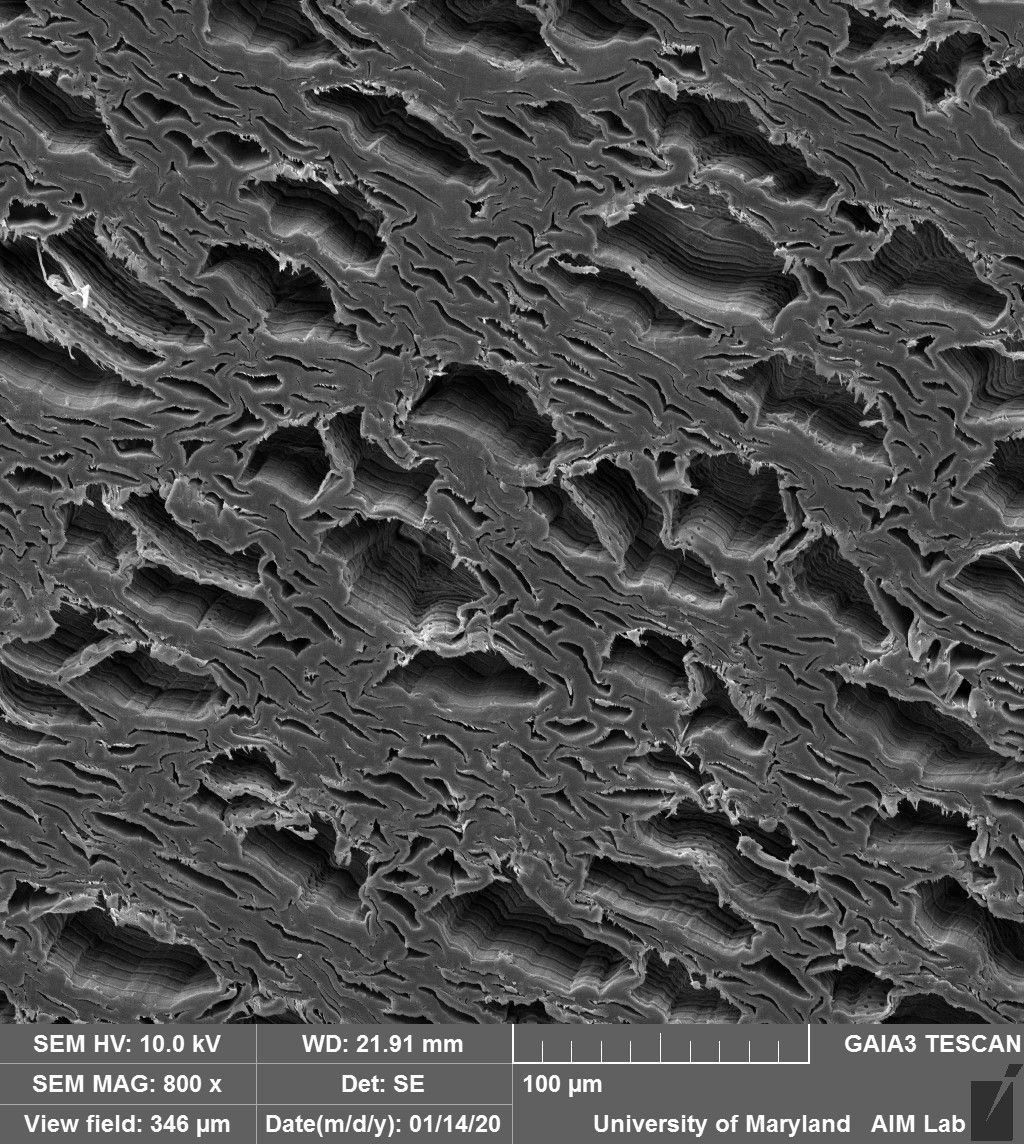Press Release
Moldable Wood from Water Shock Process
A UMD research team has developed a strong yet incredibly flexible wood material that could be used in construction, automotives and beyond.
FOR IMMEDIATE RELEASE October 21, 2021
CONTACT:
Katie Holland
301 405 0379
khollan3@umd.edu

Structures and vehicles built with sustainable materials are an increasingly desirable asset these days, if we are to meet the needs of future generations. Natural wood already boasts an inherently lower life cycle cost than other materials, and is a naturally strong, lightweight and durable material that could offer an alternative to commonly used polymers and alloys, for example, if its properties and functionality could be improved. Various approaches, such as delignification and densification, have been tried and thus far failed to provide the same formability offered by metals and plastics.
To that end, a University of Maryland (UMD) research team led by Liangbing Hu, materials science and engineering professor and director of the Center for Materials Innovation, has developed a technique for creating strong and moldable wood materials via a rapid "water-shock" process.
After dismantling the wood’s lignin – the cell walls inside wood that give it strength – which softens it, and then closing the fibers by evaporating the water, the team re-swells the wood by "shocking" it with water.
"The rapid water-shock process forms a distinct partially open, wrinkled cell wall structure that provides space for compression as well as the ability to support high strain, allowing the material to be easily folded and molded," Hu said. "The resulting 3D-Molded Wood is six-times stronger than the starting wood and comparable to widely used lightweight materials like aluminum alloys."
This ‘moldable wood’ can then be folded into different shapes and then set to dry before forming the final product. The remarkable foldability of the processed wood originates in its wrinkled cell wall structure, which can sustain severe folding without fracture.
"The authors introduce a clever means to transform the naturally occurring, straight-walled cellular structures of wood into wavy, accordion-like geometries, at the microscale," said John Rogers, professor of materials science and engineering, biomedical engineering and neurological surgery at Northwestern University."The result is an unusual, high-strength form of wood that is both flexible and moldable, in ways that open up new applications for this very old class of material."
This study, which made the cover of Science on October 22 (DOI: 10.1126/science.abg9556), was a collaborative effort between the University of Maryland, Yale University, Ohio State University, USDA Forest Service, University of Bristol, University of North Texas, ETH Zurich, and the Center for Materials Innovation.
Additional praise:
"This out-of-the-box approach to developing advanced wood materials will drive wood product and market innovation as a sustainable solution to replace many unsustainable structure materials and combat climate change," said JY Zhu at the USDA Forest Products Lab. "It will also facilitate mitigating forest thinning cost for healthy forest management to reduce wild catastrophic forest fires. We at the U.S. Forest Service Forest Products Laboratory are very excited to collaborate with Professor Hu on this research."
"Moldable wood significantly broadens the potential applications of wood as a sustainable structural material," said Teng Li, mechanical engineering professor at UMD and co-author on the study. "This concept extends wood's potential as a structural material, while reducing the environmental impact for buildings and transportation applications."
Stephen Eichhorn, a materials science and engineering professor at the University of Bristol, recalls a childhood memory of his father building his own plane out of wood. "He bent the wood to be used in the wings of the plane using steam," Eichhorn said. “To see now that it is possible to make this flexible wood, while also enhancing the mechanical properties makes this a truly amazing material, and who knows – it could be used as a future material in aerospace!"
About the A. James Clark School of Engineering
The University of Maryland’s A. James Clark School of Engineering is a premier program, ranked among the top 20 in the world. Located just a few miles from Washington, D.C., the Clark School is at the center of a constellation of high-tech companies and federal laboratories, offering students and faculty access to unique professional opportunities.
Our broad spectrum of academic programs, including the world’s only accredited undergraduate fire protection engineering program, is complemented by a vibrant entrepreneurial ecosystem, early hands-on educational experiences, and participation in national and international competitions.
The Clark School is leading research advancements in aerospace, bioengineering, robotics, nanotechnology, disaster resilience, energy and sustainability, and cybersecurity. From the universal product code to satellite radio, SMS text messaging to the implantable insulin pump, our students, faculty, and alumni are engineering life-changing innovations for millions. Learn more at www.eng.umd.edu.